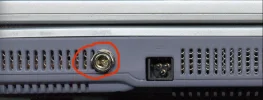Hey mgran!
I was going to post at your blog. Excellent guide! Thank you very much for your time. Great job!.
I've yet to decide if I'm more impressed by your guide or by the looks of that power cord plug in the last pic! It's not even funny.
I'm going to go the "new dc jack route" this time though. I found a cheaper EBay reseller too. (I think I remember the tech guy that soldered the pin telling me he had used silver too, not sure)
-Did you buy an entire new AC adapter or just the plug? Mine is slightly melted, don't know if it really needs replacing but I'm still curious about what you did to replace it. Ebay reseller tips would be welcome too
-About that Powerleap adapter, well I don't know about that, my Willamette is most likely not a socket 423 but one of the socket 478 Willamettes.
Actually the Desknote A928 is a socket 478 package with 400Mhz FSB , right?
And since the Pentium M I'm talking about is also a socket 478 - 400Mhz FSB, it makes me wonder if it would be a succesfull cpu swap.
I was going to post at your blog. Excellent guide! Thank you very much for your time. Great job!.
I've yet to decide if I'm more impressed by your guide or by the looks of that power cord plug in the last pic! It's not even funny.
I'm going to go the "new dc jack route" this time though. I found a cheaper EBay reseller too. (I think I remember the tech guy that soldered the pin telling me he had used silver too, not sure)
-Did you buy an entire new AC adapter or just the plug? Mine is slightly melted, don't know if it really needs replacing but I'm still curious about what you did to replace it. Ebay reseller tips would be welcome too

-About that Powerleap adapter, well I don't know about that, my Willamette is most likely not a socket 423 but one of the socket 478 Willamettes.
Actually the Desknote A928 is a socket 478 package with 400Mhz FSB , right?
And since the Pentium M I'm talking about is also a socket 478 - 400Mhz FSB, it makes me wonder if it would be a succesfull cpu swap.
Last edited:


 .
.

